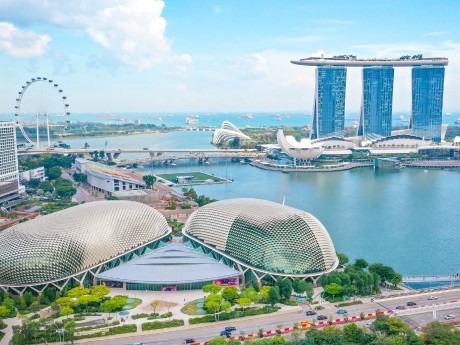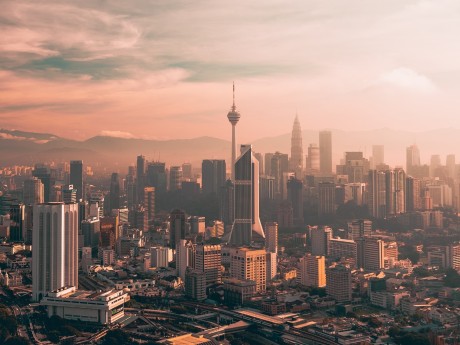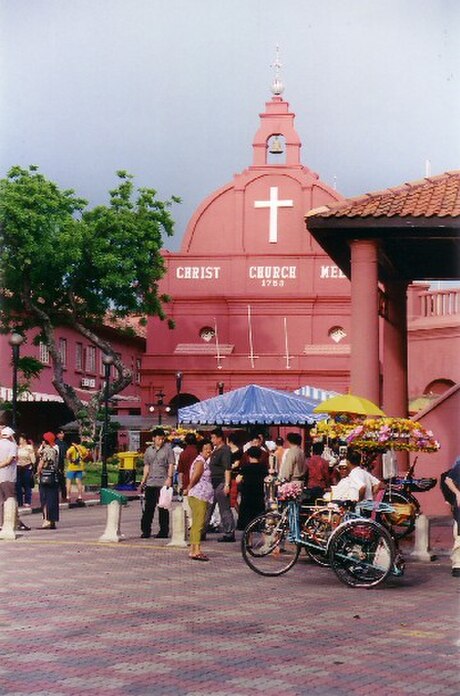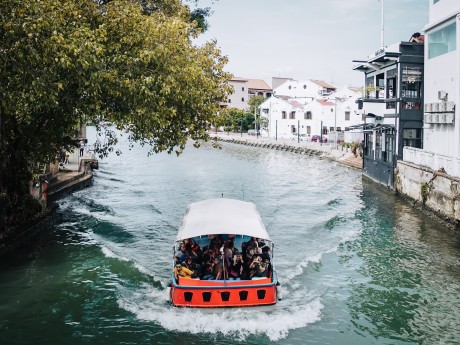Singapore and Malaysia: Singapore, Kuala Lumpur & Malacca
Welcome to the heart of the Southeast Asia region, an adventure exploring Singapore and Malaysia. In Singapore, explore the iconic Gardens by the Bay, visit the famous Merlion statue near Marina Bay Sands, or indulge in some shopping at Orchard Road. Don't miss out on trying the delicious local cuisine, such as chicken rice or laksa. A short flight will take you to Kuala Lumpur, the bustling capital city of Malaysia.
Read more
Welcome to the heart of the Southeast Asia region, an adventure exploring Singapore and Malaysia. In Singapore, explore the iconic Gardens by the Bay, visit the famous Merlion statue near Marina Bay Sands, or indulge in some shopping at Orchard Road. Don't miss out on trying the delicious local cuisine, such as chicken rice or laksa. A short flight will take you to Kuala Lumpur, the bustling capital city of Malaysia. Admire the stunning Petronas Twin Towers, stroll through the lush KLCC Park or visit the Batu Caves, a Hindu temple built into a limestone cave. For a taste of local cuisine, don't miss out on Jalan Alor, a street filled with hawker stalls selling delicious Malaysian dishes.The last stop is Malacca, a UNESCO World Heritage Site rich in history and charm. Walk along the famous Jonker Street, lined with antique shops and cafes, and visit the Stadthuys, a Dutch colonial-era building that houses a museum of Malaccan history. For a unique experience, take a river cruise and see the city from a different perspective. Waterviews strives to offer accommodation options within walking distance of water and/or in an area of touristic interest. Our prices include taxes (but excludes local tourist taxes). Customize your trip to your personal preferences with optional activities (hit the “Add Activities’’) or change hotels, etc. Contact us for customization at no extra cost at: Service@waterviews.ca
Destinations
- Singapore
- Kuala Lumpur
- Malacca
Itinerary
Singapore

Tucked between Malaysia and Indonesia, this former British colony has the world’s third highest population density as well as one of its most efficient public transport systems. An incredibly diverse country for its tiny size, Singapore’s melting pot of cultures is reflected in its varied culinary scene, and here you’ll find everything from bustling hawker markets to Michelin-starred restaurants. Singapore is easy to explore and offers something for everyone, with countless architectural highlights as well as great opportunities for shopping.
Read more
Tucked between Malaysia and Indonesia, this former British colony has the world’s third highest population density as well as one of its most efficient public transport systems. An incredibly diverse country for its tiny size, Singapore’s melting pot of cultures is reflected in its varied culinary scene, and here you’ll find everything from bustling hawker markets to Michelin-starred restaurants. Singapore is easy to explore and offers something for everyone, with countless architectural highlights as well as great opportunities for shopping.
Additional Information
The former British colony of Singapore is like no other in the world. More a city state than a country, this booming metropolis is Asia’s fourth-largest financial center and home to the world’s third-highest per-capita income. Famous for its outright cleanliness, Singapore stands out as being very tourist-friendly and easily navigable in comparison to many of its counterparts in neighboring countries.
There really is something for everyone here in this very modern city nestled in between Malaysia and Indonesia. Shopping enthusiasts can delight in the numerous malls and streets lined with high-end boutique stores and culinary aficionados can have a feast in what is considered one of Asia’s best destinations for restaurants. Those on the lookout for culturally significant activities and rich architecture will find those in leaps and bounds here.
Those wary of spending a few days in a concrete-laden modern metropolis need not despair: Singapore is in fact a very green city with an incredible juxtaposition of ancient rainforests with modern skyscrapers, plus it is home to the very Victorian Botanic Gardens and one of the world’s best zoos.
Kuala Lumpur

Kuala Lumpur is a mesmerising blend of old and new; its emblematic Petronas Towers soar above the city as a symbol of its futuristic growth while Sri Mahamariamman boasts itself as Malaysia’s oldest Hindu temple. The city’s melting pot of cultures is reflected in its varied cuisine and blend of architectural styles, and nearby visitors can discover the world-renowned Batu Caves. With its vast shopping malls, bustling street markets and lively nightlife, Malaysia’s vibrant capital has something to offer for every traveller.
Read more
Kuala Lumpur is a mesmerising blend of old and new; its emblematic Petronas Towers soar above the city as a symbol of its futuristic growth while Sri Mahamariamman boasts itself as Malaysia’s oldest Hindu temple. The city’s melting pot of cultures is reflected in its varied cuisine and blend of architectural styles, and nearby visitors can discover the world-renowned Batu Caves. With its vast shopping malls, bustling street markets and lively nightlife, Malaysia’s vibrant capital has something to offer for every traveller.
Additional Information
As in most of Malaysia’s cities and towns, Malaysian Chinese form a majority of the population, at 55%, in Kuala Lumpur. Malays (who form the majority of Malaysia's population, overall) and Malaysian Indians are also present in large numbers in the city, and there are substantial numbers of more recent immigrants and workers from South and Southeast Asia, Eurasians, and expatriates from Western countries and the Middle East. The result is a mix of cultures that meld together to make Kuala Lumpur a modern and diverse capital.
Kuala Lumpur is said to be locked in an unofficial rivalry with nearby city-state Singapore. The ethnic Chinese-dominated Singapore was separated from the indigenous Malay-majority Federation due primarily to irreconcilable ideological differences. Singapore strove to become a viable independent state and spurred rapid development, which the Malaysians sought to keep up with by investing in Kuala Lumpur. If Singapore has a first class airport, so does KL. When Singapore got an efficient urban transport system, so did KL. As Singapore becomes clean and green, so does KL. Everywhere you go, there are swats and strips of manicured public lawns and refreshing jungle-like parks - just like Singapore. If Singapore has an aquatic park and a bird park, so does KL. Same thing with an orchid park and butterfly park. If Singapore renovates and paints its colonial shop houses with tutti frutti colours, so does KL. If Singapore builds theme parks, so does KL. And if Singapore aims to be a shopping mecca with a plethora of shopping malls and all sorts of gimmicks, so does KL. What Singapore has, KL matches, often on an even grander scale. So if you've been to Singapore, you will have seen it all in KL, a bit of déjà vu, or vice versa.
Both cities' locations on the geographically, economically and politically important Bangkok-Jakarta corridor have favoured their growth. The two cities are built from the same cultural ingredients, though in different proportions: Chinese culture is more dominant in Singapore.
History
Founded in 1857 under British rule as a tin mining outpost, Kuala Lumpur is fairly new as far as Malaysian cities go and lacks the rich history of Georgetown or Malacca. Due to the success of tin mining, Kuala Lumpur began to flourish but had problems with gang fighting in the late 1800s. Following this, Kuala Lumpur faced further misfortune after much of the city burnt down in a large fire as most buildings were built from wood and thatch. As a result buildings in Kuala Lumpur were required to be built with brick and tile. After these rough early years, Kuala Lumpur began to prosper and was made capital of the Federated Malay States in 1896.
During World War II, Kuala Lumpur and the Federated Malay States were occupied by the Japanese from 1942 to 1945. During this time the economy was virtually halted. Soon after the British regained power it was declared that the Federated Malay States were to become the Malayan Union and work toward independence began. In 1952, Kuala Lumpur was one of the first cities in the Union to hold elections. Malaya's independence was declared in 1957 in front of huge crowds at what was later named Stadium Merdeka (Independence Stadium), and Kuala Lumpur continued as the new nation's capital.
In 1972, Kuala Lumpur was given city status and by 1974 became a Federal Territory of Malaysia in its own right, hence losing the title as capital city of Selangor. The economic boom of the 1990s brought Kuala Lumpur the standard trappings of a modern city, but it was severely hit by the Asian financial crisis of 1997, which stalled the Malaysian economy and led to the abandonment or delay of many construction projects. Today, Kuala Lumpur has become a modern city, bristling with skyscrapers and with a modern transportation system, and is one of the world's major centres for Islamic banking. Despite this, Kuala Lumpur has still kept some of its historical charm.
Climate
As Kuala Lumpur is only 3 degrees north of the Equator, you can expect tropical weather all year round. Shielded by the Titiwangsa Mountains to the east and Sumatra to the west, temperatures are relatively cooler than other cities within Peninsular Malaysia. Expect sunny days with temperatures above 30°C (86°F) and slightly cooler evenings, particularly when afternoon showers occur and humidity is high. Rainfall can be sporadic and quite torrential at times, but usually does not last very long. During the wet season, around October to March, the northeast monsoon brings heavy rainfall that can occasionally flood some areas of Kuala Lumpur. The months around June and July could be classed as the dry season, but even then it can frequently rain.
Occasionally, due to forest fires from Sumatra around May to October, haze can blanket the city and surrounding regions, and it is best to remain indoors if you suffer from asthma.
As the weather can be hot and humid during the day, try to dress lightly if you expect to be outside and, while it may seem obvious, don't forget to remain hydrated. Also keep in mind that mosques and some temples have strict dress codes, although many do supply gowns to cover you if you are inadequately dressed. If you do find it too hot to be outside, consider going to a shopping mall to relax and work that credit card in air conditioned comfort.
© Sourced from Wikivoyage
Malacca

As the capital of its namesake state, the city of Malacca is a diverse blend of culture and history that offers an excellent array of amenities. Boasting UNESCO World Heritage Site status, its historic centre is home to a colourful blend of architecture that ranges from temples and mosques to churches and forts, and the city’s collection of museums are well worth the visit too. Be sure to stop at Malacca’s vibrant Jonker Street Night Market to sample traditional cuisine and shop for local crafts.
Read more
As the capital of its namesake state, the city of Malacca is a diverse blend of culture and history that offers an excellent array of amenities. Boasting UNESCO World Heritage Site status, its historic centre is home to a colourful blend of architecture that ranges from temples and mosques to churches and forts, and the city’s collection of museums are well worth the visit too. Be sure to stop at Malacca’s vibrant Jonker Street Night Market to sample traditional cuisine and shop for local crafts.
Additional Information
Modern-day Malacca is a vibrant old city with a unique historical and cultural background from being the capital of a powerful Malay kingdom before the colonial era, as well as subsequent Portuguese, Dutch and British rule. The city centre was listed by UNESCO as a World Heritage Site in July 2008, along with Georgetown, Penang.
History
Before the arrival of the first Sultan, Malacca was a simple fishing village inhabited by local Malays. The Malacca Sultanate was founded by Parameswara, also called Iskandar Shah or Sri Majara, the last Raja of Singapura (the Malay name of Singapore) following a Majapahit attack in 1377. Parameswara found his way to Malacca in 1400 where he found a port, accessible in all seasons and on the strategically located narrowest point of the Malacca Strait. This later became Malacca.
There are some interesting legends surrounding the foundation and naming of Malacca. According to the 16th century Malay Annals, the city was founded by Parameswara. Some believe it more likely that he was a Hindu prince and political fugitive from nearby Java. The legend goes that Parameswara was out on a hunt in the region and had stopped to refresh himself near what is now the Malacca River. Standing near a melaka (Indian gooseberry) tree he was surprised to witness one of his hunting dogs so startled by a mouse deer that it fell into the river. Parameswara took this as a propitious sign of the weak overcoming the powerful and decided to build the capital of his new kingdom where he stood, naming it for the tree under which he had been resting. Another account says Malacca is derived from the Arabic word Malakat, meaning market. Malacca had a navigable harbor sheltered by nearby Sumatra across the narrow straits. The location was supplied with an ample quantity of fresh water, enjoyed a prime location relative to the shifting monsoon winds, and had a central location in regional trade patterns, all of which soon made it a prosperous trading town. Its fortunes increased with its official adoption of Islam in the 14th century. The Sultans of Malacca were soon attracting Arab traders from far afield. However, Malacca continued to trade with merchants of all races and religions.
After the visit of the Chinese Muslim Admiral Cheng Ho in the mid-15th century, contact between China and Malacca intensified. In exchange for protection against Siam, Malacca became a vassal state to Ming China. To ensure Malacca's safety, a new and powerful kingdom was founded by the Sultan of Samudra-Pasai.
The power of the Malays began to rise through the 15th century. In the Malay Annals, Sultan Mansur Shah was mentioned as having six wives, and the fifth was stated to be a daughter of the Ming Emperor. However, in the Chinese chronicles, no such event was recorded.
Things started to change with the arrival of the Portuguese in 1509. They were at first welcomed, but Indian traders soon turned the sultan against the Portuguese and they had to flee. In 1511 the Portuguese returned, and at their second attempt seized the city. This marked the start of the formation of a large Eurasian community. The Portuguese turned the city into a massive walled fortress complete with a tower bristling with cannon. It was believed that such fortifications could withstand the encroachments of other European powers eager for a slice of the Asian luxury goods trade.
An alliance between the Dutch and the Sultan of Johor saw the loss much of Malacca's power. In 1641 the Dutch navy put a blockade on Malacca and they seized the city after six months. During the siege much of the Portuguese city was destroyed.
Only after 150 years did the Dutch lose their hold on Malacca. In 1795 The Netherlands was conquered by the French, and the British were keen to take over the Dutch holdings in Malacca. By that time, Malacca had lost most of its former importance, although it remained an important part of Asian trade routes.
The A Famosa gate is all that remains of the old Portuguese and Dutch forts. As the Napoleonic Wars wound down the British knew Malacca would be returned to Dutch control. In order to make the city indefensible the city walls were blown down. A last minute intervention by a British officer, the young Sir Stamford Raffles (founder of British Singapore) saved the gate. Shortly after its return to Dutch rule, the Dutch and British governments swapped colonies - British Bencoolen in Sumatra for Dutch Malacca.
Malacca is a centre of Peranakan culture. When Chinese settlers came to Malacca as miners, traders and coolies, they took local brides (of Javanese, Batak, Achenese, etc. descent) and adopted many local customs. The result of this is an interesting fusion of local and Chinese cultures. The men are addressed as Babas and the women Nonyas by their servants meaning Master and Mistress.
A small group of Eurasians of Portuguese descent continue to speak their unique creole, known as Cristão or Kristang.
© Sourced from Wikivoyage





